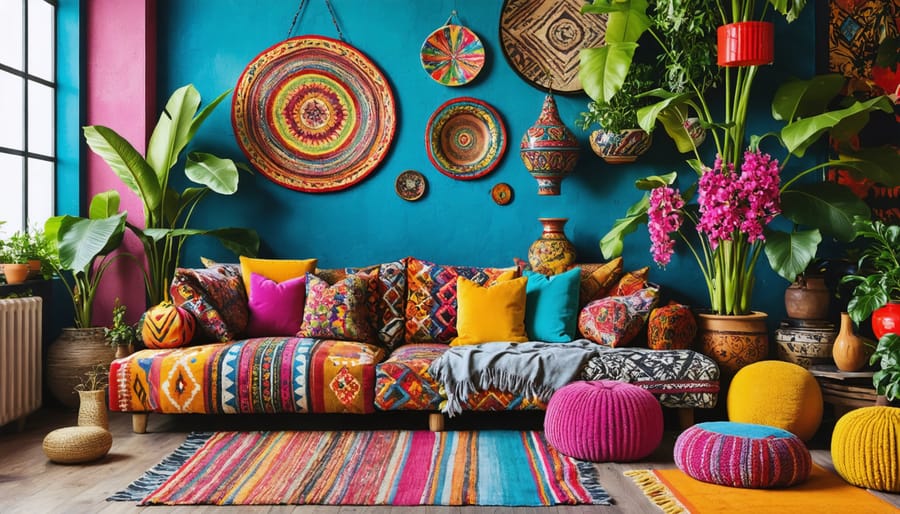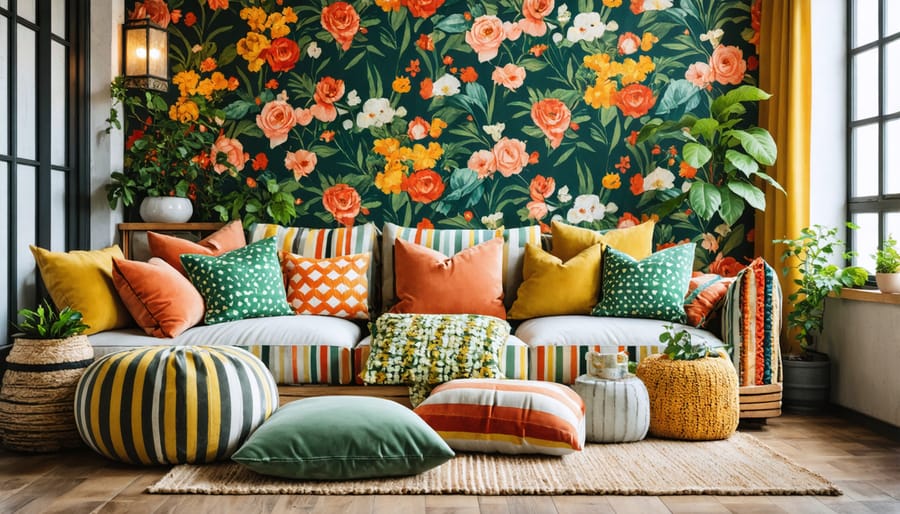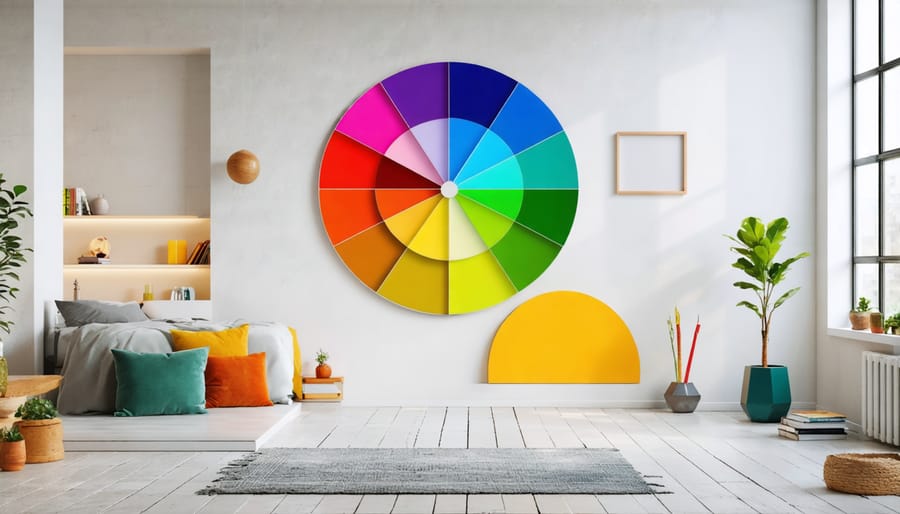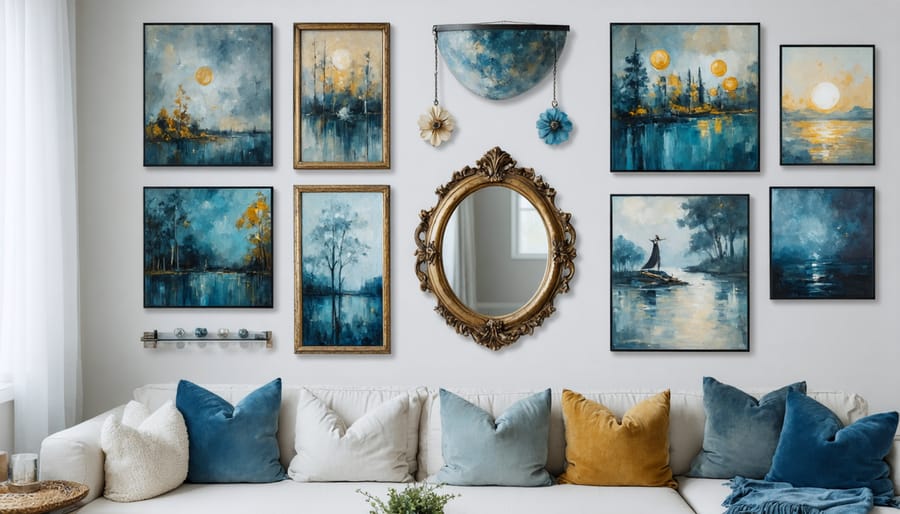
Transform ordinary spaces into captivating visual narratives by embracing the bold, layered world of eclectic maximalism. This fearless design philosophy celebrates abundance, personality, and the artful chaos of carefully curated collections. Unlike minimalism’s restraint, maximalist interiors weave rich textures, contrasting patterns, and diverse cultural influences into spaces that tell complex, personal stories. The key lies in knowing how to blend vintage with modern elements while maintaining a sophisticated balance between vibrant expression and visual harmony.
Master maximalist design by starting with a foundation of statement furniture pieces, then building layers through complementary textiles, art, and meaningful objects. The style’s true magic emerges when seemingly disparate elements – inherited antiques, global finds, and contemporary pieces – unite to create spaces that feel both curated and effortlessly collected over time. This approach isn’t about filling spaces indiscriminately; it’s about crafting intentional abundance that reflects personal history while pushing creative boundaries.
Modern maximalism challenges traditional design rules while honoring the timeless appeal of rich storytelling through interior spaces. It’s where bold color choices, pattern mixing, and theatrical displays come together to create rooms that are both conversation starters and comfortable havens.
Pattern layering is a cornerstone of eclectic maximalist design, requiring a thoughtful approach to create visual interest without overwhelming the space. Start with a dominant pattern that incorporates multiple colors, which will serve as your anchor and inform the palette for additional patterns. This primary pattern often works best on larger pieces like sofas or curtains.
Layer in secondary patterns at varying scales – pair large-scale prints with medium and small-scale designs to create depth and prevent competition between elements. A good rule of thumb is to include at least three different pattern scales in your composition. When mixing patterns, maintain cohesion by repeating at least one color throughout different prints.
Consider the pattern types carefully: combine organic shapes with geometric designs, or mix traditional motifs with contemporary patterns. Stripes and dots can act as neutrals, helping to break up more complex patterns while adding subtle texture. Animal prints, when used strategically, can function as sophisticated neutrals that bridge different pattern styles.
To avoid visual chaos, establish rhythm by repeating patterns at different points throughout the room. Use solid-colored pieces strategically to create visual rest areas, and incorporate textural elements like velvet or grasscloth to add dimension without competing with your patterns. Remember that pattern mixing is an art – trust your instincts and adjust until the balance feels right.

In eclectic maximalist design, the artful combination of textures creates a sensory-rich environment that elevates the entire space. Start by establishing a foundation with larger pieces, mixing smooth leather sofas with plush velvet armchairs to create immediate textural contrast. Layer in innovative textile combinations through throw pillows, incorporating materials like bouclé, silk, and woven tapestries to add depth.
Consider introducing natural elements like wooden furniture with prominent grain patterns alongside sleek metallic accents. Rattan or wicker pieces can provide organic texture, while glass and mirror surfaces offer smooth, reflective contrast. Don’t shy away from mixing raw materials – combine rough stone table bases with polished marble tops, or pair distressed leather with glossy ceramics.
Wall treatments present another opportunity for textural play. Layer grasscloth wallpaper with framed textile art, or combine smooth painted surfaces with textured wall hangings. Area rugs can anchor your texture story – try layering a thick shag rug over a flat-woven sisal for maximum impact.
Remember to maintain balance by distributing textures throughout the space rather than clustering similar materials together. This creates a cohesive flow while ensuring each unique texture gets its moment to shine. When selecting pieces, run your hand over surfaces – if it feels interesting to touch, it will likely add valuable dimension to your maximalist design.

Creating cohesive color stories in maximalist design requires a thoughtful approach that balances bold choices with visual harmony. Start by selecting a dominant color that resonates with your space’s primary furniture pieces, then build your palette by incorporating 3-4 complementary hues. Consider the 60-30-10 rule as a foundation, but don’t be afraid to expand it to include additional accent colors.
Layer your chosen colors through different elements – from wall treatments and textiles to decorative accessories. Rich jewel tones like emerald green, sapphire blue, and amethyst purple work exceptionally well in maximalist spaces, especially when paired with metallic accents. For a more grounded look, incorporate earth tones as transitional colors between bolder choices.
Pattern mixing becomes more manageable when you maintain color consistency across different prints. For example, if you’re working with a deep burgundy sofa, echo that shade in artwork, throw pillows, and even small decorative objects throughout the room. This creates visual threads that tie the space together.
Remember that neutrals play a crucial role in maximalist color stories – they provide necessary breathing space and help prevent visual overwhelm. Use whites, grays, or warm beiges strategically to frame your more dramatic color choices and create visual rhythm throughout the space.
While eclectic maximalism embraces vibrant colors, successful execution requires thoughtful balance to prevent visual fatigue. Start by selecting a dominant color that will serve as your foundation, then build your palette with complementary and accent hues. The 60-30-10 rule remains relevant even in maximalist spaces: use your primary color for 60% of the room, a secondary color for 30%, and bold accent colors for the remaining 10%.
Consider creating color zones within your space to guide the eye and prevent overwhelming chaos. For instance, cluster furniture and decor in complementary color families within specific areas, allowing each grouping to make its statement while maintaining harmony with adjacent zones. Deep jewel tones like emerald, sapphire, and amethyst work particularly well together, while still providing rich contrast.
To prevent visual overwhelm, incorporate neutral breaks between bold color statements. These “breathing spaces” can be achieved through natural wood furniture, metallic accents, or even strategic placement of white or cream-colored pieces. When selecting colored furniture pieces, consider how they’ll interact with existing architectural elements and natural light sources. Remember that colors appear more intense in natural daylight, so test swatches and samples at different times of day before making final decisions.
In eclectic maximalist design, the key to creating a cohesive space lies in the thoughtful balance between statement pieces and supporting elements. Your anchor pieces should command attention while telling your unique story through design. Consider an ornate vintage armchair in rich velvet or a boldly patterned Victorian sofa as your room’s focal point. These distinctive pieces, especially when crafted with sustainable material choices, become conversation starters that set the tone for your space.
Supporting elements should complement rather than compete with your statement pieces. Think of them as the supporting cast in your design story. Layer in smaller furniture items like side tables, ottomans, or accent chairs in coordinating colors or complementary patterns. These pieces should echo elements from your statement piece without overshadowing it. For instance, if your focal point is a dramatic emerald green sofa, incorporate smaller items with subtle green accents or complementary jewel tones.
The secret to successful mixing lies in maintaining a visual hierarchy. Keep approximately 70% of your furniture pieces in supporting roles, allowing the remaining 30% to serve as dramatic focal points. This ratio ensures your space feels intentionally curated rather than overwhelming, while still embracing the bold spirit of maximalist design.
In eclectic maximalist design, strategic space planning serves as the foundation for successfully layering multiple elements without creating visual chaos. Start by establishing clear pathways through your space, ensuring at least 30 inches of walking room between furniture pieces. This creates a natural flow that guides the eye through your curated collections while maintaining functionality.
Consider the concept of “anchoring zones” – designating specific areas for different activities using furniture groupings. A conversational area might feature an oversized vintage sofa paired with mismatched armchairs, while a reading nook could combine a statement chair with stacked side tables and dramatic lighting.
Layer your furniture at varying heights to create visual interest and depth. Place larger pieces like cabinets and bookcases against walls, then work inward with medium-height furniture like chairs and tables. Fill in with smaller accent pieces, ensuring each item has enough breathing room to be appreciated individually.
Use the rule of triangulation when arranging decorative elements – placing items in groups of three at different heights creates balance within the maximalist aesthetic. This technique works particularly well for styling console tables, mantels, and coffee table displays.
Remember that negative space is crucial even in maximalist design. Strategic empty areas give the eye a place to rest and prevent the space from feeling overwhelming, while highlighting your carefully curated collections.
Creating impactful displays is essential in eclectic maximalist design, where your collections and artwork serve as visual storytelling elements. Start by identifying a focal wall or area where you’ll arrange your most striking pieces. Consider creating a gallery wall that combines different frame styles, sizes, and artistic mediums – from oil paintings to vintage photographs and even sculptural elements.
Layer your displays with intention, placing larger pieces as anchors and filling spaces with smaller complementary items. The key is to maintain visual balance while embracing asymmetry. Try grouping items in odd numbers and varying heights to create dynamic arrangements that draw the eye naturally through the space.
Incorporate natural elements alongside manufactured pieces to add organic texture and depth. Consider using floating shelves at different heights to create dimensional displays that can be easily updated as your collection grows.
Color coordination doesn’t mean matching everything perfectly – instead, look for complementary or contrasting hues that create visual connections between different pieces. Use the rule of repetition to establish cohesion: repeat colors, shapes, or themes throughout your displays to create a sense of intentional design rather than random clustering.
Remember to leave some negative space around grouped items to prevent visual overwhelm. This breathing room helps each piece stand out while contributing to the overall composition. Regularly rotate and refresh your displays to keep the space feeling dynamic and prevent dust accumulation on cherished pieces.

In eclectic maximalist design, personal collections serve as the heart of your space’s storytelling, but they require thoughtful integration to avoid creating visual chaos. The key lies in establishing a deliberate balance between your cherished items and the room’s design elements. Start by grouping similar items together, creating intentional vignettes that showcase your collections while maintaining visual harmony.
Consider using cohesive display methods, such as matching frames for artwork or unified shelving systems, to bring order to diverse collections. Color coordination can tie different pieces together – for instance, arrange books by color or group items with complementary hues. When displaying multiple collections, create breathing space between groupings to prevent visual overwhelm.
Scale plays a crucial role in successful integration. Mix larger statement pieces with smaller collectibles to create dynamic arrangements. Use the rule of thirds when arranging items, and vary heights to create visual interest while maintaining balance. Remember that negative space is essential – allow some areas to remain relatively sparse to offset busier collection displays.
To maintain design coherence, identify a common thread among your collections, whether it’s color, material, or theme. This connection will help unite disparate elements into a cohesive narrative. Consider rotating collections seasonally to keep spaces fresh and prevent overcrowding. Most importantly, ensure each piece contributes to your overall design story while reflecting your personal style and interests.
Embracing eclectic maximalism is more than just following a design trend – it’s about creating a space that truly reflects your personality and tells your unique story. Throughout this exploration of maximalist design, we’ve seen how layering textures, mixing patterns, and combining diverse furniture pieces can create spaces that are both visually striking and deeply personal.
Remember that successful maximalist design isn’t about cramming every available space with objects, but rather about thoughtful curation and strategic placement. Start with pieces that spark joy and gradually build your collection, allowing each item to contribute to your overall narrative. Don’t be afraid to mix different periods, styles, and cultural influences – this is what gives maximalist spaces their distinctive character and charm.
The key to mastering this style lies in finding the right balance between boldness and cohesion. Use color stories, repeated elements, and careful furniture arrangement to create visual harmony within the abundance. Trust your instincts, but also take time to step back and evaluate the overall impact of your choices.
As you embark on your maximalist design journey, remember that there are no strict rules – only guidelines. Let your space evolve organically, and don’t hesitate to adjust and rearrange until it feels right. Your home should be a celebration of your experiences, interests, and aspirations, wrapped in layers of rich textures, bold colors, and meaningful decorative elements.